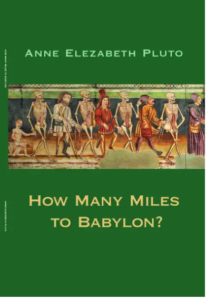 Review by Deborah Leipziger
Review by Deborah Leipziger
Fierce and gentle, Anne Elezabeth Pluto’s poems in How Many Miles to Babylon hold all of the essentials of life: love, death, memory, and books. In this powerful collection, the poet dances with the dead, recalling them with love and urgency. In these plaintive poems Pluto reminds us that grief has its own necessary beauty.
Anne Pluto writes gorgeous love poems and requiems. In her poem “Valentine”, for the Beloved, she writes
the silver moon in my hair
throw a rope around the constellations
and bring it all to me.
Loss permeates this lovely book. The loss of the Beloved lingers over us. The poet opens a window into the last chapter of the poet’s husband’s life, which feels both intimate and precious. “There is no playbook /
for the dead”.
And so we follow the poet through her dance with death, and are witness to the morphine, the menus, and what the dead leave behind.
Women play a major role in this work, from Mary and the poet Wieslawa Szymborska to Isis and the martyr, Hevrin. I love the presence of the feminine and the sacred, dwelling side by side.
What a delight it was to discover the leader Lady Deborah Moody, the only woman known to have founded a community in colonial America. She chose excommunication rather than give up her beliefs. The requiem for the human rights activist Anna Politkokkaya is a powerful tribute. In weaving these requiems and elegies, Pluto shows us how we can hold onto the sacred, which has been thwarted and — in these poems — can be revived. We are instructed, “Let everything be made holy again”.
Then it is as if we move backwards in a remembrance of loss, starting with the most recent loss of the Beloved backwards in time to losses from childhood. The book features many poems of place, which take us from Texas to Russia, and Brooklyn to Boston, weaving a theme of exile and elegy. In this work, the poet gives voice to the dead, from the martyr Hevrin to the Beloved.
Chess becomes an important motif in this book. Here the speaker of the poem plays a game of chess with the Beloved, “I let you win”.
Or is the poet playing chess with death?
Icons represent another motif from Mary to other iconic images and reliquary. In one of the most memorable poems of this book, “In my Church, Mary Wears Red” Pluto addresses the Moscow Patriarch and the Russian generals fighting to take over the Ukraine.
“Let’s take Her out of the picture…
…She wouldn’t stand
for being in the pocket of a general
scourge – the cold eastern blame
of the west. She sees the exchange
of gold and gems…
she is standing in the graves
found in Bucha – She’s wandering in
the steel plant if Mariupol — …”
Slavic words are incorporated into titles and poems, such as “slava bogu”, glory to God, which adds to the connection to Russia. The wolves of fairy tales, the forests — all of these are woven into this narrative of love and death. The color red is woven through the fabric of these poems, evoking Russia again and again. The red of berries, of blood.
Pluto helps us to remember that:
all is memory and
distance — all is love and love and
love
Anne Pluto is a brilliant poet and professor. Her new book, How Many Miles to Babylon, is a marvel. A much beloved Professor of Literature and Theatre at Lesley University, Anne is the author of six books of poetry and one of the founders and editors of Nixes Mate Press.
How Many Miles to Babylon by Anne Elezabeth Pluto
Lily Poetry Review Books, 2023
Deborah Leipziger is an author, poet, and advisor on sustainability. Born in Brazil, Deborah’s poems have been published in ten countries in such magazines as Salamander, Revista Cardenal, and Inkwell. Her poetry collection Story & Bone was published by Lily Poetry Review Books. She is the author of several books on human rights and sustainability. Deborah is currently working on a Lexicon of Change, which shares the vocabulary we need for social and environmental transformation.
